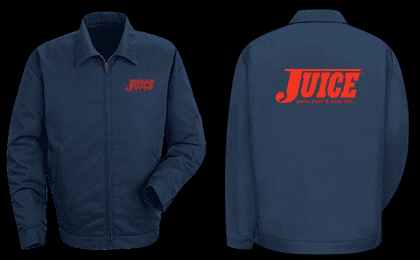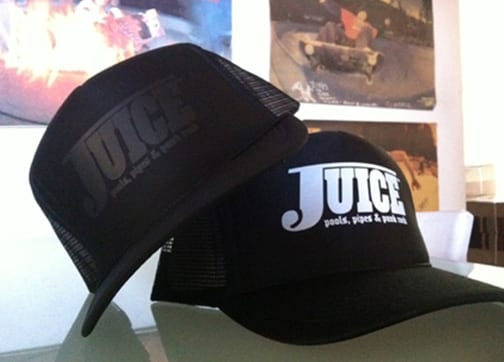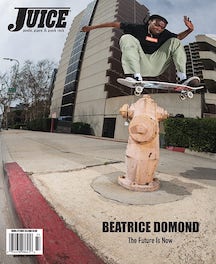INTERVIEW AND INTRODUCTION BY STEVE OLSON
PHOTOS BY IVORY SERRA AND MORGAN GHAN
This is a test of the American Broadcasting Network… Opinions… everyone has one. Then there are the ones that count… And it’s easy to tell the ones that have Matter, Mass, and some kind of substance… Truth, and all that Jazz… Who chopped down the cherry tree anyway? Ask me no questions, I’ll still tell the Truth. Ivory Serra is, all of the above…And then some… Read on my brother…For the truth is soon upon you…
“I’VE WANTED TO SKATE POOLS SINCE I WAS SEVEN YEARS OLD. THAT FEELING TRANSCENDS TIME.”
Hold on.
Okay. How’s everything out there in sunny California?
It’s sunny as ever.
[Laughs.]
You know what they say out here? It’s sextra.
[Laughs.] The sun never sets on the cool. I guess that’s why you have to wear sunglasses all the time.
[Laughs.] It’s getting bright, like the future. That was a great interview. I’ll talk to you later.
Sounds good. We don’t like to be boring, do we?
I don’t ever think it’s boring. Do you?
No. I wasn’t sure if you were going to ask the questions and edit later or what.
I faxed you the questions. You didn’t get them?
I’m actually missing that technology, to tell you the truth.
[Laughs.] Right. I was dating myself.
Actually, the fax is cool. People still ask for a fax when it’s a contract. It’s kind of weird.
It’s so they can have a hard copy. The last time I did something with Deutsch, they were like, “Fax me this. Fax me that.” I was like, “What? Are you in the 1990s?”
[Laughs.] I was reminiscing about skateboarding history and there was a point where filmmaker Jon Malvino was premiering a film at this party in Northern California. Shelter and I were like 14 or 15. The movie had Rob Roskopp in it. It was kind of cheesy with ditches, downhill spillways and stuff. They were surf/skateboarding movies.
Well, Rob Roskopp is not a surf/skateboarder.
[Laughs.] No. No. No. Jon Malvino was.
Malvino. Yes. Roskopp. No.
It was an embarrassment to the history of Santa Cruz skateboarding.
That’s just proof that people will buy product even with bad advertising as long as there is enough of it.
Yeah. There were probably eight different ridiculous boards of his.
[Laughs.] Don’t get me started. We’re interviewing you and you had to take me to that place in my mind. I had to be hypnotized to get that out of my brain.
[Laughs.]
Could you imagine some weird Californian guy doing that? “Well, I had some bad memories, so they hypnotized me and now I don’t think about them anymore… ”
That could only happen in California.
Guess what, buddy. It happens in New York, too.
People do go to shrinks, so to speak.
Did you ever learn anything from a psychologist?
No. It was a waste of time, basically.
Let me get to the real question. Did you get any meds from it or not?
No. I’ve never delved into the pharmaceutical/medical world in terms of doctors. Actually, I’ve never broken any major bones, so it’s never been that bad.
You’ve never broken a bone?
I’ve broken fingers and toes. I had a minor contusion on my thigh and couldn’t bend my leg for six to eight months. When it gets cold, it still hurts to bend my leg. I hurt my neck once.
When you were trying to imitate Cab?
No.
You didn’t find any humor in that?
[Laughs.] I remember him at the San Jose warehouse. He used to rip and he still does. I like his style.
He does the “Cabiwerial”. That’s what the chick on the X Games called it.
Cab was at the Autumn Bowl skating with Christian, Gonz, Omar, me, Shelter and Kessler and he did a frontside invert on that over vert wall.
He rips. Let’s get over it, all right?
[Laughs.] I’m stoked on him. You start the questions.
Where did you grow up?
I grew up in Bolinas, California. It’s 40 minutes north of San Francisco off Highway 1.
Is that where you started skateboarding?
Exactly.
Is that where you started taking photos?
I started taking photos on summer vacations to my grandmother’s house. My mom grew up in Utah and as kids we’d drive Highway 80 to Ogden and hang out there with our grandmother. We’d take little bus rides and go to Baja and Acapulco. Every summer there were road trips of some sort.
Were you shooting landscapes at all?
No. I still have the first roll of film that I ever shot. It was from a 110 camera. I was in Utah. There was a movie called Red Dawn, which showed an invasion of America. It started in a classroom situation and everyone was looking out the window. That was the brick building right across the street from my grandmother’s house. It was close to the Promontory Point where the railroads met. That first roll of pictures was family-oriented. I have two brothers and two sisters. I’ve always taken pictures of my family traveling. Then in high school, there was a photo class. At the same time, Shelter and I had a vert ramp. I had a Sims Hosoi board from Skates on Haight with City Streets.
City Streets were some of the best wheels ever.
A friend of ours, Will Beckman, had this small ramp. People would come from San Francisco to skate this 8 1/2 -foot tall ramp that was 16 feet wide. That’s where Shelter and I learned how to drop in. Tommy Guerrero came out there and did Andrechts on the ramp. It was a northern California getaway. It was only an hour from San Francisco. There’s always been a ramp in Bolinas. We were young and doing the junior lifeguard thing. There was a great channel to surf.
Did you surf in Bolinas?
Yeah. Growing up there, it was a fishing and surfing type town. When you’re 12 or 14, you start doing things on your own. Your parents aren’t as supervisional, so Shelter and I checked out the junior lifeguard program in Stinson Beach. There was a junior lifeguard competition at Cal’s Beach when I was 16. That was probably the first time we went down to Santa Cruz. Derby Park was the cool skate spot at the time. There weren’t a lot of skateparks like there are now. It was like a step into the past. It was a cement park. Then they built the Palo Alto Skatepark. We had a vert ramp for three years in Bolinas. It was in Thrasher from ’86 to ’88.
Where did you learn how to ride?
I’d say northern California. When we were young, that whole Embarcadero scene was going on.
So you were up in there in the ’80s?
Yeah, it was ’85 or ’86. That was 20 years ago. There was a YMCA ramp near Haight St. and Golden Gate Park. There was a lot of action there. Every Sunday they would close the park and there were ramps. Do you remember Concrete Jungle, the old skate shop?
Yeah. Carlo’s place.
They put out a street skating model called Board to Death.That’s when Coco Santiago moved from New York. Shelter and I would skate Embarcadero at night with James Kelch. I don’t want to talk about the whole New York/West Coast emerging situation because that’s not important.
Oh, no. Let’s talk about that. What’s the difference between New York and California?
Well, there’s a big difference between Northern California and Southern California, too. In California, in many ways, skating is different.
Well, one basic difference is the weather.
I think skateboarding is more enjoyable in California because you have a horizon that you’re constantly in relationship to. Whether it’s a ramp, pool, curb or ledge, you have more space to see the sky and it really makes a difference. When you’re skating in a dense environment like New York, you’re looking at traffic and, at certain times of day, it’s too dark to skate, or there are too many people walking on the street. New York City has limiting factors, which aren’t as common in California. Let’s say you park your car at Atwater Village and you see a bank. You can jump out of your car and skate it. Bam. That’s something you couldn’t do in New York. I think there is less security in California and more space and more land.
So you have San Francisco and New York. There are similarities except San Francisco has a lot of hills.
[Laughs.] There are some hills here.
[Laughs.] You have Central Park and the slope between 38th and 34th. If you want to go up really high, fine, but Ivory… San Francisco is a city built on hills and New York is primarily flat.
San Francisco is where Shelter and I learned to skate. We were seeing Tommy Guerrero and the CBS crew out near Fort Miley going down the hills to Fulton Street. That’s how I learned to skate. We skated the curb cuts too. In New York, there are no good curbs. It’s unfortunate.
You are so excellent. Let me break it down to you. I don’t look at curbs. Period. It’s a generational difference. That’s all.
There are no curb cuts in New York City. If you go to southern California, there are the ones in the old video of Natas ripping near the Sadlands.
He’s a curb cutter.
There are none of those in Manhattan. It’s unimportant.
It’s as important as you want it to be. Who is that talking in the background?
Shelter. He said, “There are no lawns and driveways in New York.” When we were young, we’d go down to Newport Beach. Our dad was doing a case down there.
Your dad is radical. I never use that word, but he is a dope ass dude.
Yeah, he’s still going strong. He’s working on a case in Fresno and has this huge Bronco that he’s been driving back and forth from San Francisco for the last two weeks.
You and Shelter are twins so you had your brother to skate with all the time. Not everyone grows up with that opportunity.
We grew up skating and traveling.
When you went on family vacations, you and Shelter had your skateboards with you once you got into skateboarding?
Oh, yeah. When we were 12 or 13, we had grown up skating in Bolinas. Then we were thinking about what high school we should go to. We played baseball growing up.
Jock. What position?
[Laughs.] I played third base. Then I played outfield. Our father was a really good baseball player. Our younger brother, Chime, played for Berkeley and Pepperdine. He was really good.
Do you follow baseball now?
No, I have no real interest in sports. I like watching some games, but when the Super Bowl comes up, I understand the importance for some people, but not me.
Have you ever been on a skate team?
No. When Shelter and I were 17 we got shoes from Vans. Steve Van Doren is a great guy. He flew us down there and we got to check out the factory and their ramp with that over-vert extension. I still remember that photo of Chris Miller.
You’re like a historian.
Well, there are distinctive moments that you remember. I’m totally into history.
I know this. It’s nothing more than actually acknowledging that you use your brain.
You know which picture I’m talking about right?
I have no idea. I stopped looking at those magazines in 1980.
I try to keep up with the magazines.
I look at magazines more now than I ever did.
I keep all the magazines. I looked at the recent Juice Magazine three or four times.
Do you like to watch videotapes?
Well, videotapes were the predecessors to the DVD. There’s a point to all the old 411 stuff and Hocus Pocus days. There’s the Baker stuff that’s kind of fun. It takes a lot of time to sit down and watch all those videos though.
Do you think you get more out of a video than you do out of a photo?
I think it depends on the trick. I don’t take a lot of sequence photos. I try to look at something more as a still image than the movement by the camera. Looking at some of the tricks these days, it’s almost like sky surfing. It’s like those guys in the air with a camera. You have to document it because it only happens once. Instead, I like the idea of looking at the environment and the skaters within that environment. You’re not superimposing anything. I like sequences, but I think the still image is a little more of a challenge.
FOR THE REST OF THE STORY, ORDER ISSUE #65 BY CLICKING HERE…
SHARE THIS POST:
- Click to email a link to a friend (Opens in new window)
- Click to share on Tumblr (Opens in new window)
- Click to share on LinkedIn (Opens in new window)
- Click to share on Pinterest (Opens in new window)
- Click to share on Twitter (Opens in new window)
- Click to share on Facebook (Opens in new window)
- Click to share on Reddit (Opens in new window)
- Click to print (Opens in new window)











